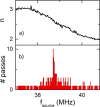Nanoscale true random bit generator based on magnetic state transitions in magnetic tunnel junctions
- PMID: 31666671
- PMCID: PMC6821798
- DOI: 10.1038/s41598-019-52236-z
Nanoscale true random bit generator based on magnetic state transitions in magnetic tunnel junctions
Abstract
We present an investigation into the in-plane field induced free layer state transitions found in magnetic tunnel junctions. By applying an ac current into an integrated field antenna, the magnetisation of the free layer can be switched between the magnetic vortex state and the quasi-uniform anti-parallel state. When in the magnetic vortex state, the vortex core gyrates a discrete number of times, and at certain frequencies there is a 50% chance of the core gyrating n or n - 1 times, leading to the proposal of a novel nanoscale continuous digital true random bit generator.
Conflict of interest statement
The authors declare no competing interests.
Figures




References
-
- Kim, J. et al. Nano-Intrinsic True Random Number Generation: A Device to Data Study, IEEE Trans. Circuits Syst. I Regul. Pap., pp. 1–12 (2019).
-
- Tehrani S, et al. Magnetoresistive random access memory using magnetic tunnel junctions. Proc. IEEE. 2003;91(5):703–714. doi: 10.1109/JPROC.2003.811804. - DOI
LinkOut - more resources
Full Text Sources

